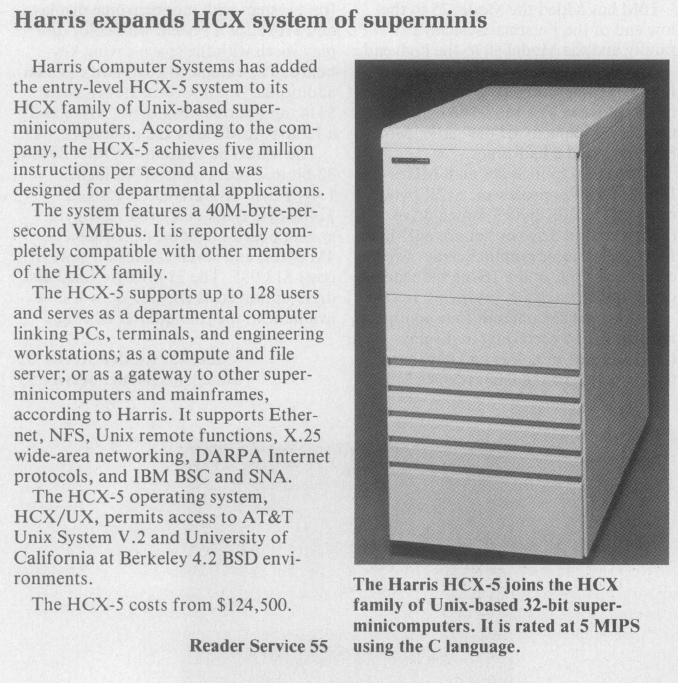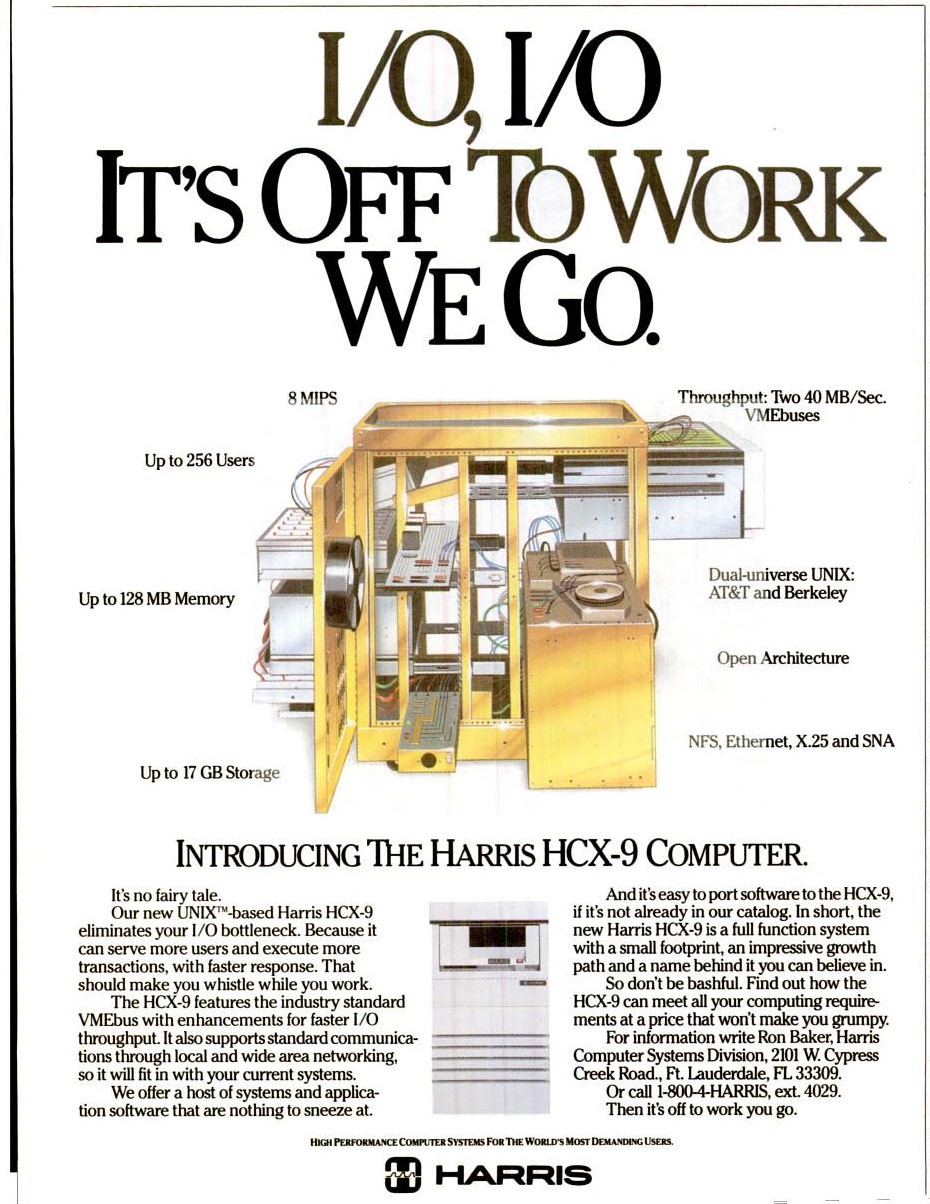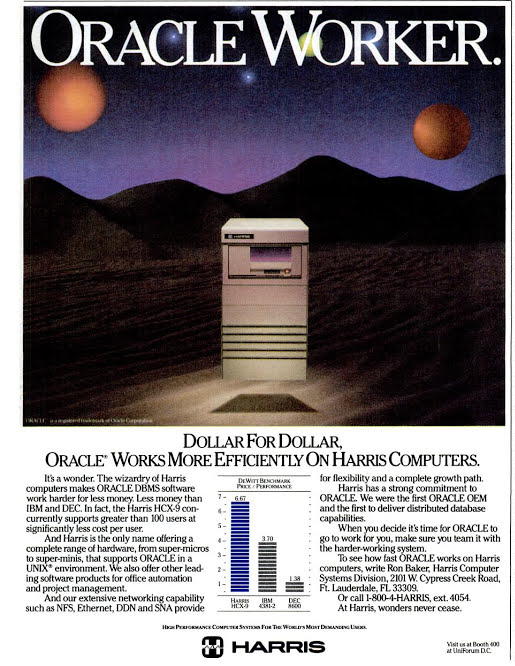A machine born in legend
This is a machine that is shroud in legend, and of course played an integral part of internet history but oddly enough almost all trace of it ever existing has vanished.
The release of BSD, aptly named the 4.3BSD TAHOE release was completed in June of 1988. However shortly after this release the makers of the CPU, Computer Consoles Incorporated abruptly exited the market killing off the platform. Â What is interesting though is that while CCI was manufacturing the TAHOE processor, they also sold it to 3 other OEM’s, Sperry (which merged with Buroughs, and re-branded as Unisys), and ICL Ltd. and Harris is the only other one to have picked up the CPU for inclusion in it’s own machines. Â Among them was the HCX-7, and the HCX-9.
The Harris HCX minicomputers were one of the possible machines that the CSRG team at Berkeley saw as a possible successor to the aging VAX line of minicomputers for their operating system.  While this may not have been the first port of UNIX or BSD for that matter, it was the first port of a 32bit BSD, that was included into the main VAX BSD source, and as such could be redistributed with the BSD license (which at the time required an AT&T 32V license).  The fundamental thing this did was to split out the VAX specific code as a mainstream port was to be rolled back into the main CSRG source, unlike any other 3rd party port at this point.
The HCX-5 ran an internal version of 4.2BSD, along with SYSV in a ‘dual universe’ config, while the HCX-9 was to be supported by the CSRG, as the file GENERIC.hcx9 indicates from 4.3BSD TAHOE. Â As you can see the HCX-5’s starting price of $124,500 USD is if anything a continuing of the mindset that BSD only ran on super expensive minicomputers.
POWER 6/32 = HCX-9
Indeed from the config file in 4.3BSD TAHOE, we see this:
GENERIC POWER 6/32 (HCX9)
And for quite some time, I’ve always been searching for a CCI POWER 6/32, meanwhile it appears that was merely a reference platform that became the HCX-9 as indicated from the machine config file. Â The evidence was hiding in plain sight, as always it was a typo that lead me here as I was searching for TAHOE processors, and came across people looking for GCC on the TAHOE, running BSD. Â And following their threads I noticed that they were running Harris minis’ which then lead me to make the connection that the TAHOE was a processor, not just a machine, and that other vendors sold their own machines with the CPU.
Future cut short
Needless to say, once CCI exited the market these machines evaporated so quickly that they are only remembered in legend in BSD. Â I’ve seen people debate if the machine actually existed, who put it out, or even what was it exactly? A workstation? Server? Â As we can see from the Harris models, it was meant to be a minicomputer, to compete with the likes of the Digitial VAX.
As we can see from this ad, with Oracle support and the official porting target of the CSRG the HCX-9 was expected to have a bright future. Â Instead it was cut so short there is barely any mention of it even existing.
Sadly this minicomputer target idea continued, as the CSRG sidestepped the commodity 32bit processors, namely the cheaper 68020 & 80386.




I agree. Interesting problem.
To get into the gory details about the CCI/BSD deal, contact Mike Karels, who was BSD lead at the time. I happened to run a Power 6/32 while at GE/Calma in 85, it was a great machine! The unix dual universe idea came from Pyramid Technology, another great piece of risc unix how from the 80s.
I’d LOVE to talk to someone from the era… A small interview would be fantastic.. For some reason the whole Tahoe thing is largely erased from the net’s memory.
Look up Mike on LinkedIn – he’d be able to point you to key names at CCI. If you’re also interested in Pyramid Technology, let me know.
Or you can ask me. I was 1/34 of the team which designed and built the Tahoe Power 6/32 (I did the C compiler).
I really have dropped the ball on this one, so let me email you!
I’m amazed that such an important ‘missing link’ in the evolution of BSD has basically been eradicated from history.
Is that what that strange sound coming from your neck of the woods is?
For my part, I’d really like to find a single VME bus or dual VME bus backplane and power supply for a probably just as old Motorola board I have.
Let’s just say I’ll also need a wire-wrap capable prototyping board……
I used to run a couple of Harris machines back in the late 80’s. One was a hybrid with dual I/O buckets – both Versabus and HVME. The other was a straight HVME based HCX-9. I even went on the hardware maintenance training course in Fort Lauderdale at Harris’s office on West Cypress Creek Rd. At the time, they were developing a dual processor ECL version of the TAHOE processor, but it never came to be. It actually ran from what I understand, but they shredded everything from they developed in order to be able to claim it as a total write off. They decided to switch to Mororola 88k RISC CPUs in their newer Nighthawk series. I still have the product briefs on the ECL TAHOE somewhere in my basement.
Hi Neozeed/Clayton/Helge etc.
I am wondering did you ever come across any product brochure on the HCX range or other systems in the CCI range as I am looking for information to add to our Computer History preservation online efforts.
Regards Mark
In the credits of the 1985 movie Young Sherlock Holmes there is a reference:
Power 6/32 Computer Systems supplied by COMPUTER CONSOLES, INC.
That is interesting! Now I wonder who and how it was made
Wow. I figured no one ever knew about the HCX-7 and HCX-9. I was a grad student in at the University of Dayton in the School of Engineering computer center. We got an HCX-9 as a donation. Harris wanted to sell computers to the Air Force (Wright Patterson AFB is nearby and the University does a lot of work). I was the Sysadmin for four years until I graduated. I think it went away around 1995 or 1996. Good box. We used for general Unix programming. I learned named configuration on that system. Long time ago…..
they evaporated into legend so quickly. It’s funny but for so long if you asked around about this ‘Tahoe’ port of 4.3BSD, but wtf is a Tahoe you’d get nothing but people sheepishly not knowing. It’d been a long time quest of mine to figure it out!
Like many things I guess, it’s common enough to get a nickname, but once it drops out of use, it just loses all significance.
After some research I found that Luxo Jr. was rendered on Power 6/32. Where can I find photos of this computer?
Looking at here: https://www.quora.com/How-long-did-it-take-to-render-the-original-Pixar-Luxo-Jr-short-film
According to the ACM article “The Reyes image rendering architecture” from July 1987, frames from Luxo Jr. each took 1.5 hours of CPU time to render at a resolution of 724×434.
In the same ACM volume within the article “Rendering Antialiased Shadows with Depth Maps”, we learn that the computation time for a sample frame from Luxo Jr. including shadows was 88.8 minutes using Reyes on a CCI Power 6/32 computer.
With the short film’s running time being 174 seconds and assuming 24 FPS, it took ~2,131 minutes (or ~35 hours) for a single second of Luxo Jr. to be rendered in 1985 / 1986.
So for the complete short film, I would suggest that it took around 370,000 minutes (or ~6,166 hours) to render, which comes out to ~257 days. It’s not clear to me how many CCI Power 6/32 computers were available to Pixar at the time, though, to handle the rendering in a shorter number of days.
As far as system images, all I found was the advertisements on the post.
Until I managed to figure this out, I never found anything definitive what a ‘Tahoe’ even was. Maybe one day someone will surface with a computer room image, but I don’t see that happening anytime soon sadly, this machine was basically scrubbed from history.
I was fortunate to be in charge of Tahoe. Send me an e-mail and I can send you some information.
SENT!